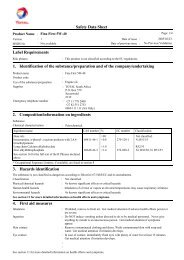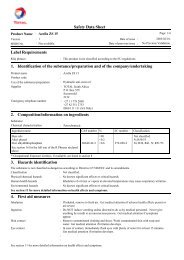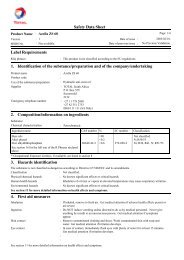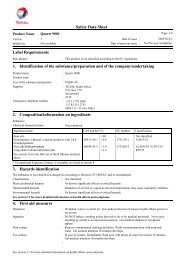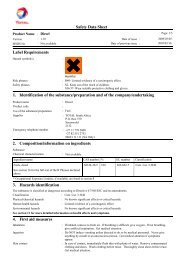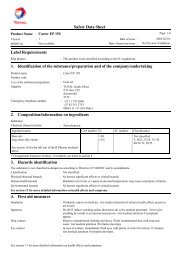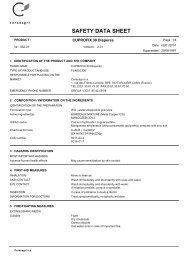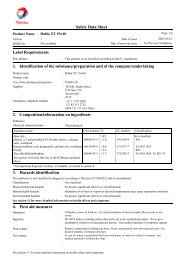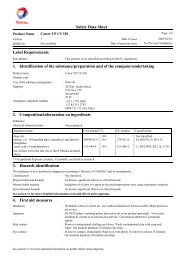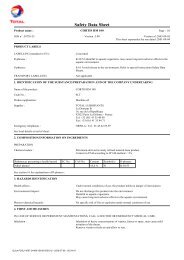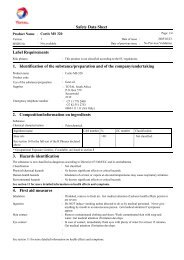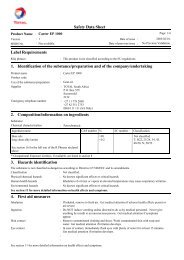Cortis 150.pdf - total tec
Cortis 150.pdf - total tec
Cortis 150.pdf - total tec
You also want an ePaper? Increase the reach of your titles
YUMPU automatically turns print PDFs into web optimized ePapers that Google loves.
Product Name : <strong>Cortis</strong> 150<br />
Safety Data Sheet<br />
Version : 1<br />
Date of issue :<br />
MSDS No. : Not available.<br />
Date of previous issue :<br />
Page: 2/4<br />
2005/02/23.<br />
No Previous Validation.<br />
5.<br />
Fire-fighting measures<br />
Extinguishing media :<br />
Special exposure hazards<br />
:<br />
Hazardous thermal decomposition :<br />
products<br />
Special pro<strong>tec</strong>tive equipment for firefighters<br />
:<br />
Remark :<br />
6. Accidental release measures<br />
Personal precautions<br />
Environmental precautions<br />
Methods for cleaning up :<br />
7.<br />
Handling<br />
Storage<br />
Handling and storage<br />
Packaging materials<br />
Recommended<br />
8. Exposure controls/personal pro<strong>tec</strong>tion<br />
Ingredient name<br />
oil mist, mineral<br />
Occupational exposure controls :<br />
Respiratory pro<strong>tec</strong>tion :<br />
Hand pro<strong>tec</strong>tion<br />
Eye pro<strong>tec</strong>tion<br />
:<br />
In case of fire, use water spray (fog), foam, dry chemicals, or CO2.<br />
Never direct a water jet in the container in order to prevent any splashing of the product<br />
which could cause spreading of the fire.<br />
No specific hazard.<br />
These products are : carbon oxides (CO, CO2).<br />
Fire fighters should wear appropriate pro<strong>tec</strong>tive equipment and self-contained breathing<br />
apparatus (SCBA) with a full facepiece operated in positive pressure mode.<br />
If fire can be controlled, cool container with water from unmanned hose holder or<br />
monitor nozzles until well after fire is out.<br />
: Use suitable pro<strong>tec</strong>tive equipment (Section 8).<br />
Avoid dispersal of spilled material and runoff and contact with soil, waterways, drains<br />
and sewers.<br />
If emergency personnel are unavailable, contain spilled material. For small spills add<br />
absorbent (soil may be used in the absence of other suitable materials) scoop up material<br />
and place in a sealed, liquid-proof container for disposal. For large spills dike spilled<br />
material or otherwise contain material to ensure runoff does not reach a waterway. Place<br />
spilled material in an appropriate container for disposal.<br />
: Wash thoroughly after handling.<br />
: Keep container tightly closed. Keep container in a cool, well-ventilated area.<br />
Combustible materials should be stored away from extreme heat and away from strong<br />
oxidizing agents. Outside or detached storage is preferred.<br />
:<br />
:<br />
:<br />
Use original container. Empty containers retain product residue and can be hazardous.<br />
Occupational exposure limits<br />
ACGIH TLV (United States, 9/2004). Notes: Adopted Values enclosed<br />
are those for which changes are proposed. Consult the Notice of<br />
Intended Changes for current proposal. See Notice of Intended<br />
changes.<br />
STEL: 10 mg/m 3 15 minute(s). Form: All forms<br />
TWA: 5 mg/m 3 8 hour(s). Form: All forms<br />
Provide exhaust ventilation or other engineering controls to keep the airborne<br />
concentrations of vapors below their respective occupational exposure limits. Ensure that<br />
eyewash stations and safety showers are proximal to the work-station location.<br />
Use a properly fitted, air-purifying or air-fed respirator complying with an approved<br />
standard if a risk assessment indicates this is necessary.Respirator selection must be<br />
based on known or anticipated exposure levels, the hazards of the product and the safe<br />
working limits of the selected respirator.<br />
Chemical-resistant, impervious gloves or gauntlets complying with an approved standard<br />
should be worn at all times when handling chemical products if a risk assessment<br />
indicates this is necessary.<br />
Recommended: nitrile rubber, neoprene.<br />
Safety eyewear complying with an approved standard should be used when a risk<br />
assessment indicates this is necessary to avoid exposure to liquid splashes, mists or dusts.



